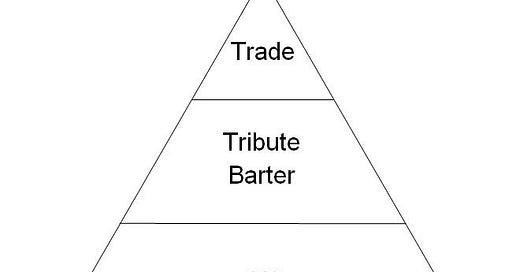How not to be a (very) poor artist: Part 1
Lessons on gift economy when market economy is not cutting it
A week ago, I posted a note about a basic income pilot program for artists in Ireland. I wondered if this is a pain point for artists who do not have a stable paycheck. From the response to this note, it most definitely is. Institutional and governmental support is key to ensuring the arts economy stays alive.
These programs can temporarily offset the inevitable. Artists face structural poverty and existential disappointment. Average incomes are low and unpredictable, and the high barriers are unforeseen until too late. Internal subsidization (support from family, second jobs, etc.) disguises the structural failures of the arts economy. Artists also do not enter the art world with a complete understanding of its workings; there is a lot of misinformation about the arts and being successful as an artist. There is also no formal control of numbers in the arts, and anyone can be an artist, which can cause overcrowding and competition for a minimal number of opportunities.
The author of the book ‘Why Are Artists Poor? The Exceptional Economy of the Arts’ Hans Abbing1 says that the arts economy comprises both pre-capitalist (gift-based, personal, dependent) and a capitalist (winner-takes-all) system. This sets the arts apart, at least in the Western world. While most of the western industrialized world is driven by the market economy, the art world contradicts that because the gift-based pre-capitalist systems account for a big chunk of how the art world operates.
The gift economy plays a unique and deeply rooted role in the art world. Unlike in most other professions, art often circulates through informal networks of care, trust, mutual inspiration, and unspoken obligation. While the gift economy can be exploited to extract unpaid labor or justify precarity, it can also be a powerful tool for solidarity, autonomy, and survival—if artists strategically use it.
Artists can use the gift economy to their advantage—not to escape capitalism entirely, but to alleviate systemic poverty and build collective power. This is especially important since individual artist incomes can sometimes be non-existent, and artists often sacrifice themselves at the altar of art.
Here are some strategic tactics with case studies later in the article on how artists might use the gift economy to their advantage to pull each other out of systemic poverty.
🔁 1. Make Reciprocity Visible
Problem: The art world often disguises gifts as “exposure,” while genuine reciprocity is obscured.
Strategy: Be explicit about what you're offering and what you expect in return. Whether it’s emotional labor, space, feedback, or time, track and name value.
Tactic: Write up mutual aid agreements, publish rates for collaborative work, or co-create a “gifting log” within your artist collective.
🤝 2. Build Artist-Led Economies
Problem: Institutional dependence leads to gatekeeping and scarcity.
Strategy: Use gifting to seed trust, then organize reciprocal economies (like time banks, barter circles, or production co-ops) outside of traditional structures.
Tactic: Start a shared studio fund, materials co-op, or skills exchange with a few trusted peers. Create a “gift circle” where each member states what they need and what they can offer.
🛠️ 3. Translate Gifts Into Tangible Assets
Problem: Emotional and social support are powerful, but don’t pay rent.




